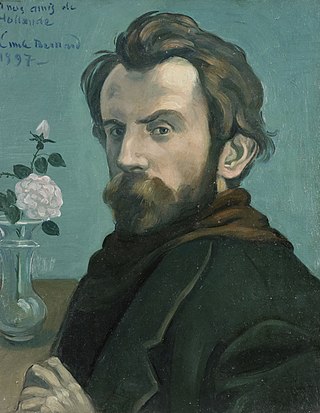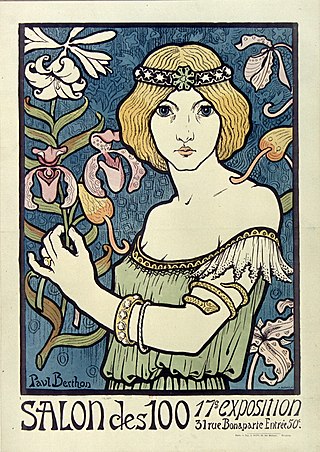
Le Sourire was a French monthly magazine that was published between August 1899 and April 1900. [1]

Le Sourire was a French monthly magazine that was published between August 1899 and April 1900. [1]
Le Sourire was a monthly periodical published by the French artist Paul Gauguin. [2] The editions contained satirical copy, illustrated by his pen and screen drawings, with one of his woodcuts used for the header. It was in part inspired by the more successful Parisian periodical Le Rire , illustrated by artists such as Toulouse-Lautrec. [3]
A total of nine editions were printed during August 1899 and April 1900, between his stays in Tahiti and the Marquesas Islands. It is not known how many copies of each edition were printed, probably not more than 30. Due to a limited budget, and the fact that they were hand printed, the quality of the reproductions was often poor and blotchy, he used cheap glue to bind the leaves to the paper. [4] However, they are admired by art critics and historians today.
A second version of Le Sourire began on 25 August 1899 under the operation of Maurice Mery, who had experience with art review journals and newspapers. This weekly version came out on Saturdays under the editorship of Alphonse Allais. Le Sourire suspended publishing with the advent of the First World War, but resumed on 14 April 1917 with Rudolphe Bringer at the helm.

The revived magazine was known as Le Sourire de France and had more risque content, frequently featuring covers with pin-up style art and jokes. In 1922 Paul Briquet became the director and held the position until 1930. The magazine itself continued with weekly publication until 30 September 1939, when it became bi-weekly. However, this ended in May 1940 with the fall of France. [5]

Comte Henri Marie Raymond de Toulouse-Lautrec-Monfa, known as Toulouse Lautrec, was a French painter, printmaker, draughtsman, caricaturist, and illustrator whose immersion in the colourful and theatrical life of Paris in the late 19th century allowed him to produce a collection of enticing, elegant, and provocative images of the sometimes decadent affairs of those times.

Eugène Henri Paul Gauguin was a French painter, sculptor, printmaker, ceramist, and writer, whose work has been primarily associated with the Post-Impressionist and Symbolist movements. He was also an influential practitioner of wood engraving and woodcuts as art forms. While only moderately successful during his lifetime, Gauguin has since been recognized for his experimental use of color and Synthetist style that were distinct from Impressionism.

Post-Impressionism was a predominantly French art movement that developed roughly between 1886 and 1905, from the last Impressionist exhibition to the birth of Fauvism. Post-Impressionism emerged as a reaction against Impressionists' concern for the naturalistic depiction of light and colour. Its broad emphasis on abstract qualities or symbolic content means Post-Impressionism encompasses Les Nabis, Neo-Impressionism, Symbolism, Cloisonnism, the Pont-Aven School, and Synthetism, along with some later Impressionists' work. The movement's principal artists were Paul Cézanne, Paul Gauguin, Vincent van Gogh and Georges Seurat.

The Nabis were a group of young French artists active in Paris from 1888 until 1900, who played a large part in the transition from Impressionism and academic art to abstract art, symbolism and the other early movements of modernism. The members included Pierre Bonnard, Maurice Denis, Paul Ranson, Édouard Vuillard, Ker-Xavier Roussel, Félix Vallotton, Paul Sérusier and Auguste Cazalis. Most were students at the Académie Julian in Paris in the late 1880s. The artists shared a common admiration for Paul Gauguin and Paul Cézanne and a determination to renew the art of painting, but varied greatly in their individual styles. They believed that a work of art was not a depiction of nature, but a synthesis of metaphors and symbols created by the artist. In 1900, the artists held their final exhibition and went their separate ways.

Le Rire was a successful French humor magazine published from October 1894 until its final issue in April 1971. Founded in Paris during the Belle Époque by Felix Juven, Le Rire appeared as typical Parisians began to achieve more education, income and leisure time. Interest in the arts, culture and politics intensified during the Gay Nineties. Publications like this helped satisfy such curiosity. It was the most successful of all the "Journaux Humoristiques."

Pierre Bonnard was a French painter, illustrator and printmaker, known especially for the stylized decorative qualities of his paintings and his bold use of color. A founding member of the Post-Impressionist group of avant-garde painters Les Nabis, his early work was strongly influenced by the work of Paul Gauguin, as well as the prints of Hokusai and other Japanese artists. Bonnard was a leading figure in the transition from Impressionism to Modernism. He painted landscapes, urban scenes, portraits and intimate domestic scenes, where the backgrounds, colors and painting style usually took precedence over the subject.

Alphonse Allais was a French writer, journalist and humorist. He was also the editor of the Chat Noir, a satirical magazine.

La Plume was a French bi-monthly literary and artistic review. The magazine was set up in 1889 by Léon Deschamps, who edited it for ten years and was succeeded as editor by Karl Boès from 1899 to 1914. Its offices were at number 31 rue Bonaparte, Paris. From its beginning, famous artists such as Willette, Forain, Eugène Grasset, Toulouse-Lautrec, Maurice Denis, Mucha, Gauguin, Pissarro, Félicien Rops, Signac, Seurat, and Redon contributed to it. One of its most famous issues is that devoted to Le Chat noir. The magazine supported the symbolist art movement.

Émile Henri Bernard was a French Post-Impressionist painter and writer, who had artistic friendships with Vincent van Gogh, Paul Gauguin and Eugène Boch, and at a later time, Paul Cézanne. Most of his notable work was accomplished at a young age, in the years 1886 through 1897. He is also associated with Cloisonnism and Synthetism, two late 19th-century art movements. Less known is Bernard's literary work, comprising plays, poetry, and art criticism as well as art historical statements that contain first-hand information on the crucial period of modern art to which Bernard had contributed.

The Neue Pinakothek is an art museum in Munich, Germany. Its focus is European Art of the 18th and 19th centuries, and it is one of the most important museums of art of the nineteenth century in the world.

Maxime-Pierre Jules Dethomas was a French painter, draughtsman, printmaker, illustrator, and was among the best known theater-set and costume designers of his era. As an artist, Dethomas was highly regarded by his contemporaries and exhibited widely, both within France and abroad. He was a regular contributor to the Impressionistes et Symbolistes, and a founding committee member of the Salon d'Automne. In 1912, he was awarded the Chevalier de la Légion d'honneur for his contributions to French art.

Pierre-Georges Jeanniot (1848–1934) was a Swiss-French Impressionist painter, designer, watercolorist, and engraver who was born in Geneva, Switzerland, and died in France. His work often depicts the modern life in Paris.

René-Paul Schützenberger was a French Post-Impressionist painter.

Le Moulin de la Galette is the title of several paintings made by Vincent van Gogh in 1886 of a windmill, the Moulin de la Galette, which was near Van Gogh and his brother Theo's apartment in Montmartre. The owners of the windmill maximized the view on the butte overlooking Paris, creating a terrace for viewing and a dance hall for entertainment.

Salon des Cent was a commercial art exhibition in Paris, based at 31 Rue Bonaparte. The Salon sold color posters, prints and reproductions of artwork to the general public at reasonable prices. It was established in February 1894 by Léon Deschamps, founder of La Plume an avant garde literary and artistic magazine. It became known for its exhibitions showcasing the works of contemporary graphical artists. The salon held exhibitions until 1900. Many of the posters advertising Salon des Cent exhibitions have themselves become collectors' items.
Fernand-Louis Gottlob was a French graphic artist whose caricatures appeared in many humorous magazines.

Archibald Standish Hartrick was a Scottish painter known for the quality of his lithographic work. His works covered urban scenes, landscapes and figure painting and he was a founder member of the Senefelder Club.

L'Estampe originale was a French periodical publishing portfolios of original prints in a limited edition of 100 for subscribers. It produced nine issues quarterly between 1893 and 1895, containing a total of 95 original prints by a very distinguished group of 74 artists, including Henri de Toulouse-Lautrec, Gauguin, Renoir, Pissarro, Whistler, Paul Signac, Odilon Redon, Rodin, Henri Fantin-Latour, Félix Bracquemond, Félicien Rops and Puvis de Chavannes. Almost all of Les Nabis contributed: Pierre Bonnard, Maurice Denis, Paul Ranson, Édouard Vuillard, Ker-Xavier Roussel, Félix Vallotton, and Paul Sérusier. British artists included William Nicholson, Charles Ricketts, Walter Crane and William Rothenstein; besides Whistler, Joseph Pennell was the only American.

The JOB collection is a production of graphic works consisting of calendars, posters and postcards advertising the JOB rolling paper factory. Artistic in character, it was illustrated by renowned painters and poster artists, mainly during the Art Nouveau period.